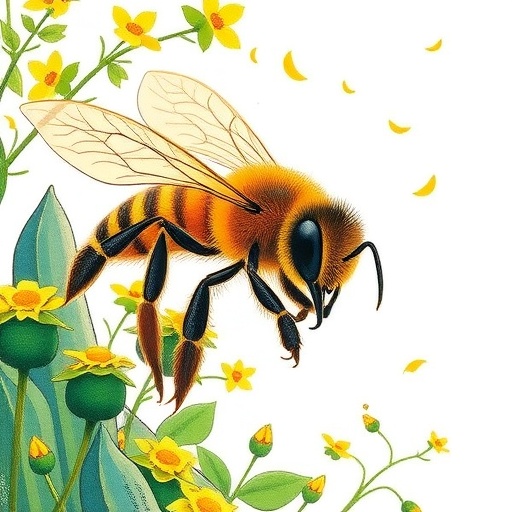Emerging scientific research has begun to illuminate the intricate relationships between bees and their environments, particularly in agricultural settings. In a groundbreaking study, Giovanetti et al. delve into the functional traits of bee populations and how these traits respond to various agro-environmental factors. This research is not just a mere academic exercise; it carries significant implications for designing effective farm-level indicators that can help in monitoring and improving biodiversity. The findings pave the way for a nuanced understanding of how agricultural practices influence not only bee health but also their role as crucial pollinators within ecosystems.
The study highlights that bees, as keystone species in many ecological networks, require careful scrutiny, especially in agricultural landscapes where they often face a myriad of stressors. Factors such as pesticide use, habitat fragmentation, and climate change are harmonized into the analysis, illustrating the pressing need for strategies that can bolster bee resilience. The functional traits that researchers target include morphological features, behavioral patterns, and ecological roles, each of which interacts dynamically with the surrounding environment. By dissecting these traits, the study aims to provide a comprehensive framework that farmers and ecologists alike can employ to assess the impact of agricultural policies on bee populations.
In the context of escalating environmental challenges, understanding bee functional traits is increasingly critical. Giovanetti and colleagues underscore that these traits are indicators of the overall health of bee communities. By cataloging response patterns to various agro-environmental variables, researchers hope to pinpoint specific management practices that can enhance bee welfare and, in turn, agricultural productivity. This alignment benefits not merely the bees themselves but the entire agricultural sector, which relies heavily on pollination services to sustain crops.
One of the key breakthroughs of the study is the identification of different adaptive mechanisms that bees utilize in response to agricultural pressures. Some bee species demonstrate remarkable flexibility in their foraging strategies, allowing them to thrive even in less-than-ideal conditions. Conversely, other species are more specialized, thriving only under specific environmental conditions. Such insights allow for targeted conservation measures, ensuring that farming practices do not inadvertently push these vulnerable species toward decline. Moreover, the differentiation between generalists and specialists within bee species is pivotal as it directly impacts the effectiveness of pollination in diverse agricultural setups.
What stands out from the research is the proposed integration of these findings into practical applications within farming communities. Giovanetti et al. argue for the development of a farm-level indicator system, wherein farmers can routinely assess the functional traits and overall health of bee populations on their land. This innovative system could facilitate proactive management, enabling farmers to make informed decisions that positively affect both their yields and local biodiversity. In fostering an environment where bees thrive, farmers also protect their livelihoods, as healthy pollinator populations lead to improved crop yields and quality.
The implications of this research extend far beyond the realm of agriculture. Behavioural plasticity in bee populations, particularly in response to agro-environmental stressors, serves as an indicator of broader ecological resilience. Understanding these dynamics can inform biodiversity conservation strategies across various ecosystems. The significance of maintaining biodiversity cannot be overstated, as it contributes to the stability of ecosystems, resilience to climate change, and overall planetary health.
Furthermore, as the world grapples with the dual crises of species extinction and food insecurity, research such as this calls for immediate action. It serves as a clarion call for policymakers, farmers, and conservationists to collaborate and forge sustainable agricultural practices that are mindful of their ecological consequences. The challenge lies not just in understanding the science, but in translating these insights into actionable strategies that prioritize both agriculture and biodiversity conservation.
This study undeniably encourages future exploration into agroecological approaches that benefit both bees and agricultural productivity. Innovations in practices such as organic farming, integrated pest management, and habitat restoration could be bolstered by the findings, leading to a modern agricultural paradigm that respects and nurtures the natural world. Although the road ahead involves many challenges, the synergy between ecological health and agricultural advancement highlighted by Giovanetti et al. offers a hopeful vision for what sustainable practices can achieve.
Moreover, as awareness continues to rise about the vital role that bees play in our ecosystems, this research strengthens the argument for more robust funding and support for pollinator health initiatives. Engaging communities, fostering research partnerships, and implementing educational campaigns around the importance of bees can catalyze grassroots movements that drive change towards a more sustainable agricultural future.
In conclusion, Giovanetti et al.’s research provides profound insights into the intricate relationships between bees and their agro-environment. By exploring functional traits and their responses to various environmental pressures, this study lays the groundwork for developing indicators that can enhance both bee welfare and agricultural resilience. As the final takeaways suggest, fostering an environment conducive to bees is not merely beneficial but essential for maintaining biodiversity and ensuring food security in an ever-evolving world.
In light of these crucial findings, it is evident that the conservation of bee populations should be a priority not only for environmentalists but also for the agricultural community at large. Striking a balance between productivity and ecological integrity is no longer a lofty ambition but a necessary action plan for tomorrow’s farming practices. As we grasp the far-reaching implications of this research, it becomes apparent that bees are more than just pollinators; they are vital contributors to the complex web of life that sustains us all.
Subject of Research: Bee functional trait response to the agro-environment
Article Title: Exploring bee functional trait response to the agro-environment: a possible contribution to the future design of a farm-level indicator
Article References: Giovanetti, M., Zenga, E.L., d’Agostino, M. et al. Exploring bee functional trait response to the agro-environment: a possible contribution to the future design of a farm-level indicator. Environ Monit Assess 197, 1003 (2025). https://doi.org/10.1007/s10661-025-14394-8
Image Credits: AI Generated
DOI:
Keywords: Bee functional traits, agro-environment, biodiversity, agricultural practices, pollination services, ecological resilience, conservation strategies.




